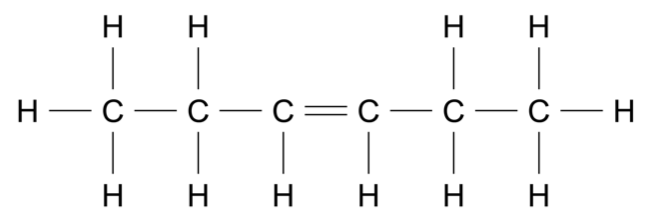The chemical environment of an atom depends on the species surrounding that atom within a molecule.
In which of the following compounds does the number of carbon chemical environments equal the number of proton chemical environments?
Aussie Maths & Science Teachers: Save your time with SmarterEd
The chemical environment of an atom depends on the species surrounding that atom within a molecule.
In which of the following compounds does the number of carbon chemical environments equal the number of proton chemical environments?
Acetone can be reduced, as shown. --- 4 WORK AREA LINES (style=lined) --- --- 10 WORK AREA LINES (style=lined) --- a. Acetone: Product: b. \({ }^{13} \text{C NMR}\) Spectroscopy: a. Acetone: Product: b. \({ }^{13} \text{C NMR}\) Spectroscopy:
The \({ }^{13}\text{C NMR}\) spectrum of an organic compound is shown below.
The organic compound could be
\(D\)
\(\Rightarrow D\)
Consider the following molecule.
How many peaks will be observed in a \({ }^{13} \text{C NMR}\) spectrum of this molecule
\(C\)
\(\Rightarrow C\)
An organic reaction pathway involving compounds \(\text{A, B,}\) and \(\text{C}\) is shown in the flow chart.
The molar mass of \(\text{A}\) is 84.156 g mol\(^{-1}\).
A chemist obtained some spectral data for the compounds as shown.
| \( \text{Data from} \ ^{1} \text{H NMR spectrum of compound C} \) | ||
| \( Chemical \ Shift \ \text{(ppm)} \) | \( Relative \ peak \ area \) | \( Splitting \ pattern \) |
| \(1.01\) | \(3\) | \(\text{Triplet}\) |
| \(1.05\) | \(3\) | \(\text{Triplet}\) |
| \(1.65\) | \(2\) | \(\text{Multiplet}\) |
| \(2.42\) | \(2\) | \(\text{Triplet}\) |
| \(2.46\) | \(2\) | \(\text{Quartet}\) |
| \( ^{1} \text{H NMR chemical shift data}\) | |
| \( Type \ of \ proton \) | \( \text{δ/ppm} \) |
| \( \ce{R - C\textbf{H}3,R - C\textbf{H}2 - R}\) | \(0.7-1.7\) |
| \( \left.\begin{array}{l}\ce{\textbf{H}3C - CO - \\-C\textbf{H}2 - CO -}\end{array}\right\} \begin{aligned} & \text { (aldehydes, ketones,} \\ &\text{carboxylic acids or esters) }\end{aligned}\) | \(2.0-2.6\) |
| \( \ce{R - C\textbf{H}O} \) | \(9.4-10.00\) |
| \( \ce{R - COO\textbf{H}} \) | \(9.0-13.0\) |
Identify the functional group present in each of compounds \(\text{A}\) to \(\text{C}\) and draw the structure of each compound. Justify your answer with reference to the information provided. (9 marks)
--- 28 WORK AREA LINES (style=lined) ---
Compound \(\text{A}\): Alkene

Compound \(\text{B}\): Secondary alcohol
Compound \(\text{C}\): Ketone

Reasoning as follows:
Compound \(\text{A}\): Alkene

Compound \(\text{B}\): Secondary alcohol
Compound \(\text{C}\): Ketone

Reasoning as follows:
Compound `text{X}` shows three signals in its \(\ce{^{13}C NMR}\) spectrum.
Treatment of `text{X}` with hot acidified potassium permanganate produces a compound `text{Y}`. Compound `text{Y}` turns blue litmus red.
Compound `text{X}` produces compound `text{Z}` upon reaction with hot concentrated sulfuric acid.
Which of the following correctly identifies compounds `text{X}`, `text{Y}` and `text{Z}`?
`D`
`=>D`
A \( \ce{^13C NMR} \) spectrum is shown.
Which compound gives rise to this spectrum?
`A`
`=> A`
A bottle labelled 'propanol' contains one of two isomers of propanol.
--- 6 WORK AREA LINES (style=lined) ---
--- 6 WORK AREA LINES (style=lined) ---
a. Isomer 1:
Isomer 2:
b. Identifying isomers with \( \ce{^13C NMR} \) spectroscopy:
c.
a. Isomer 1:
Isomer 2:
b. Identifying isomers with \( \ce{^13C NMR} \) spectroscopy:
c.
Which isomer of \(\ce{C6H14}\) would have the fewest signals in \(\ce{^13C NMR}\)?
`D`
`=> D`